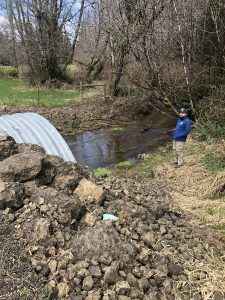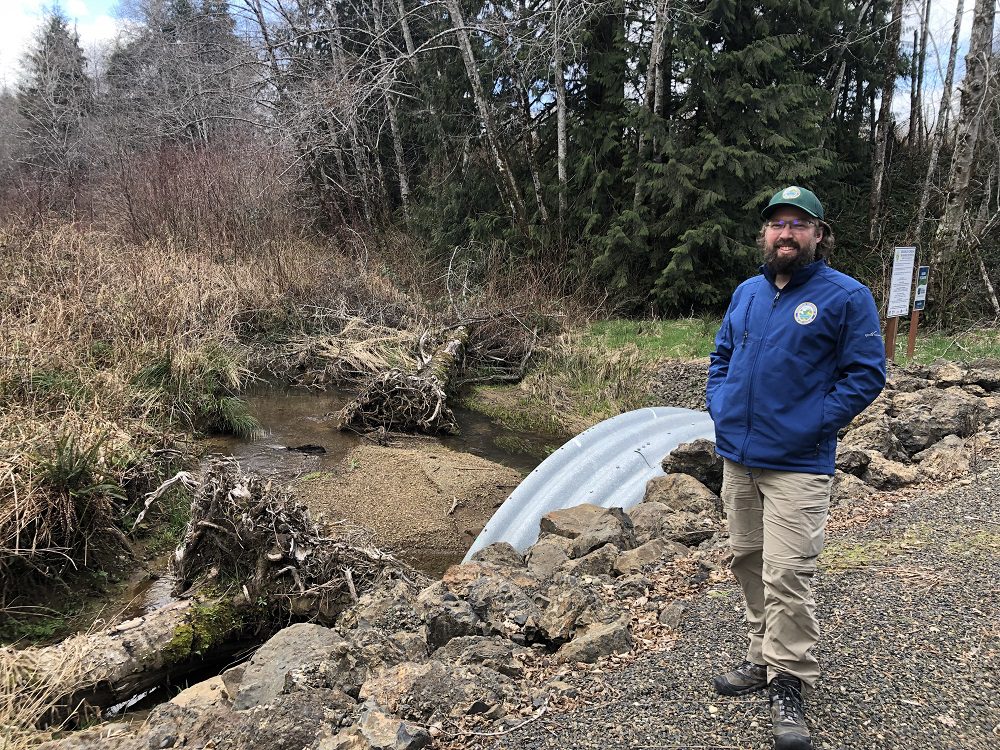Submitted by Chehalis Basin Lead Entity
Adam Fleming is a Fish Passage Biologist with the WA State Department of Fish and Wildlife (WDFW), where he has worked since 2018. His first assignment with WDFW was as a technician looking at undersized culverts and other fish passage barriers. Previously, Adam worked with Oregon Fish and Wildlife and as an onboard fisheries observer, where he collected data while on commercial fishing vessels and at onshore processing plants. As a fish observer, working long hours, in challenging environments on the open sea, Adam developed strong skills in working well in adverse conditions and how to relate to others.

Growing up landlocked north of Santa Fe, New Mexico, the ocean “called” to Adam, so he chose to move to more coastal states. He went to college in Rhode Island and in California and received a BS in Biology before moving to Seattle. He and his wife will soon be Hoquiam residents — the closest to the ocean yet.
Adam especially loves going to the beach, fishing, and seeing fish and whales around the San Juan Islands and on the Washington coast.
“It’s just beautiful here, not just visually, but how the seasons blend together,” said Adam of the Pacific Northwest.
As a WDFW biologist, much of Adam’s work is “boots on the ground” including tasks with the Chehalis Basin Strategy and The Aquatic Species Restoration Plan (ASRP). The ASRP prioritizes habitat restoration for the species that will benefit the most, particularly salmon and steelhead.
“I really like my job — it’s generally 50% indoors and 50% outdoor work –in all sorts of weather. Before we conduct our fieldwork, there is lots of planning to do, including studying satellite imagery to identify areas of interest for later fieldwork to “ground truth” the quality of salmon habitat,” shared Adam.
Adam works closely with fellow WDFW biologists, and with biologists from the Chehalis Tribe and from other state and local agencies. His work involves meeting with local landowners to conduct qualitative habitat surveys to assess the health of ecosystems.

“I have found that 99% of landowners are interested in learning more about the ASRP, and why the Chehalis Watershed is important, and ways to connect with other groups,” shared Adam. “Based on this work, the plan is to create maps that show prioritized stream reaches within the basin.”
Collaborating with local landowners is a special activity for Adam.
“One of my favorite parts of my job, for sure, is meeting with landowners. I love making connections — educating — and being educated on the history of properties, land uses and wildlife sightings. I enjoy changing perceptions of working with the state, and I provide a face that’s friendly and they respect me – and I respect the landowners. All really want what’s best, even though may think differently.”
Adam also works with the Brain Abbott Fish Barrier Removal Board (FBRB) on helping private landowners, cities and counties replace failing culverts.
“It is estimated that there are more than 18,000 failing culverts in Washington state. Replacing WA State Dept. of Transportation barriers is not effective if there’s a downstream blockage.”
“We can create great habitat but have to provide salmon and other fish the access to this great habitat,” added Adam.
To understand if a culvert is failing, extensive surveying is needed, including the assessment of the gradient of the culvert and the river, water surface drops, velocity, how to access and other survey parameters.

A recent project that exemplified community collaboration in the restoration of salmon habitat, according to Adam, was the recent replacement of three failing culverts on Geisler Creek, located in the outskirts of Montesano.
The project involved working with two landowners, Grays Harbor County, and the Chehalis Basin Fisheries Task Force with partial funding from the Salmon Recovery Funding Board (SRFB).
“FBRB grant funding and other grants are available for salmon restoration projects that have good habitat, the potential for good access to upstream habitat, the significance of salmon barriers, are well-designed and “shovel ready,” shared Adam.
The three failing culverts were replaced with a bottomless culvert and two bridges, which has opened up access to 2.35 miles of stream spawning and rearing habitat for Chinook, coho, chum salmon and steelhead and cutthroat trout. Local construction companies were also employed for the culvert work.
“Our motto is to give the fish a chance. It may have been 50 or 100 years since salmon were seen in a creek, but a stray will find and use the stream reach — if the habitat is available,” said Adam.
“Salmon have taught me so much about how all things are interconnected. They are the bridge between the ocean and the land. Salmon swim — and eat — and spawn — and die — and by doing so deliver marine nutrients to the land — no questions asked. Pretty amazing.”
Another aspect of Adam’s job as a Fish Passage Biologist is the inspection of “fishways” —structures built alongside culverts to allow fish passage and to help determine how effective they are.
“As a fish passage biologist, helping to assess salmon habitat for restoration, I sometimes get to get sweaty in the rain, crash through blackberry, duck under vine maples — which are shading the stream, and keeping the water cool. I get on my hands and knees — and get to see deep pools with coho salmon swimming in them. Spawning gravel is often present and so are fry salmon. There I get to find lots of secret places that salmon love and that few people know about.”
From these experiences, Adam well understands that salmon needs are different than human wants.
“Salmon have dissimilar needs of streams than our human-centric vision — which often include human access, cleared banks and beaches,” said Adam.

Adam encourages landowners to ask the big questions about their potential land use actions: how might your vision and goals for your property affect wildlife and everything else that utilizes the habitat — including your downstream and upstream neighbors? How might these actions affect animals that do not have a voice?
In musing on his role as a salmon biologist, Adam said “I have learned how important it is to be mindful in our actions, because of the interconnectedness of everything. There are also so many ways individuals make a difference, even if you don’t own land,” Adam added. “Volunteer with an organization like Grays Harbor Stream Team, or conservation districts, where you can make a difference.”
Contact Information for Adam Fleming
Scoping Biologist 2- Fish Passage Division, Washington Department of Fish & Wildlife,
360.522.0909
Adam.Fleming@dfw.wa.gov
To learn how you can be involved in projects that support salmon recovery, visit the Chehalis Basin Lead Entity website. Or contact Watershed Coordinator, Kirsten Harma at 360.488.3232.
Story and Photographs by Kathy Jacobson, Education and Outreach for the Chehalis Basin Lead Entity











































